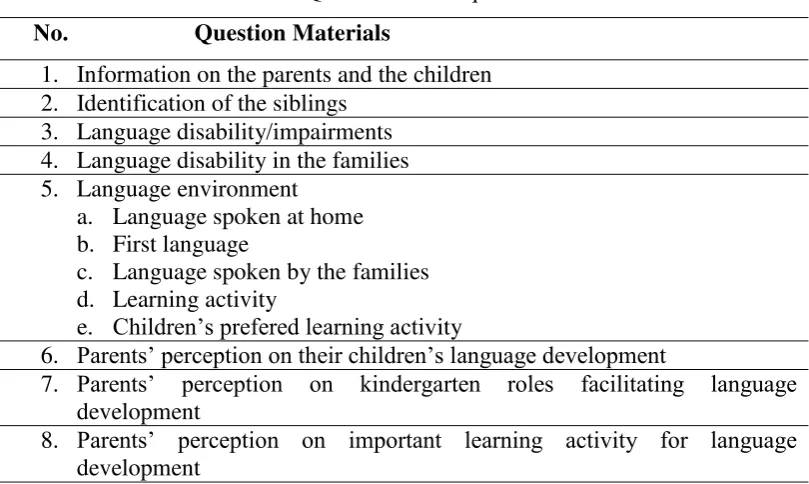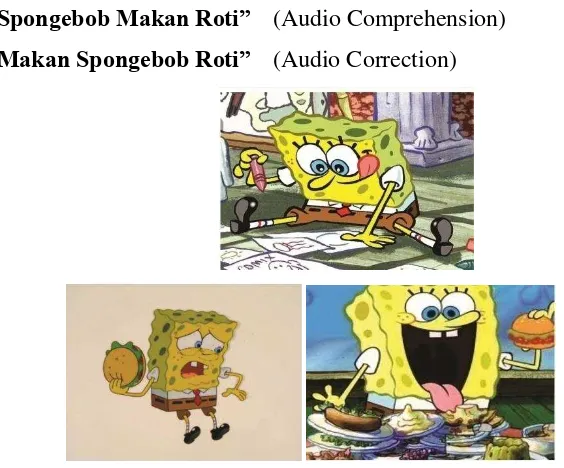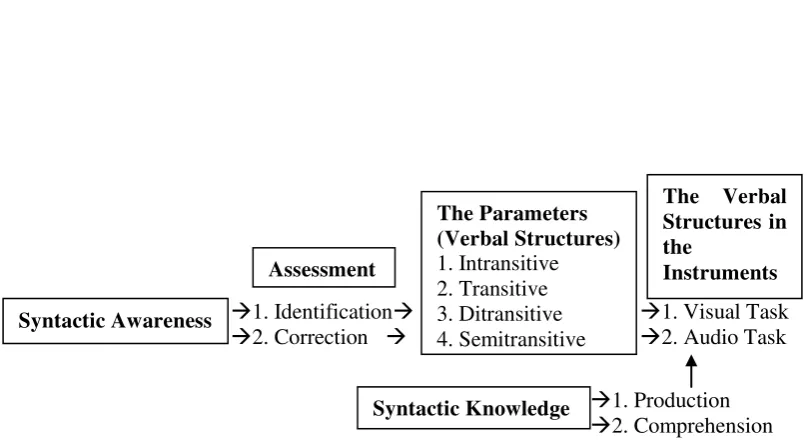CHAPTER III METHODOLOGY
This chapter presents the methodology to investigate children syntactic awareness in a kindergarten in North Bandung. The chapter is subdivided into research design; participants; data collection consisting of instruments, materials, and procedure; data analysis; and concluding remarks. They are all the grounded mechanism in conducting this research.
3.1. Formulation of Problem
This study was generally aimed at investigating 5-and 6-year-old children’s syntactic awareness in preschool. Particularly, this study assessed these points.
1. How is preschool students’ syntactic awareness in identifying and correcting intransitive, transitive, ditransitive, and semitransitive structures?
2. Do bilingualism and birth order influence syntactic awareness?
3.2. Research Design
This study employed a mixed method (qualitative and quantitative) to describe syntactic awareness in preschool students comprehensively. In particular, this study took place in a kindergarten in North Bandung for one month. This kindergarten did not teach reading, writing, and computing calistung. That teaching program was the reason for this study to take into account the kindergarten as the object of research. This study employed descriptive statistics and t-test to describe the data. As is explained by Strauss and Corbin (2003), even though the data were analyzed using statistics, the numerical data only served as supplemental to the qualitative data. This study further explored the external factors, both bilingualism and birth order.
in this case but the quality of their syntactic awareness, and the influencing factors were also important to describe a phenomenon. As what the name implies,
“qualitative” is the approach to study a phenomenon, behavior, and so on, not by
statistics or mathematical procedures. 3.3. Participants
In the beginning, 20 preschool students took part as the participants in all tasks, but one student, coded as S20, was excluded, for he was said to be hearing impaired. S20 had the moderate hearing impairments. The left one was 80db and the right 70db. In doing the visual and audio tasks, S20 was mostly wrong and lost 7 scores. Thus, for the representatives of qualitative and quantitative research, the primary data for this study were collected from 19 preschool students only as the primary subjects, and they did not have hearing impairment. Some of them could read, and some others could not.
These preschool students were 5 and 6 years old from a kindergarten in North Bandung. Tsang and Stokes (2001) and Tausch (2012) explained that the acquisition of metalinguistics or syntactic awareness should commence in phase 3 at around five years of age and consolidated in phase 4 at six or seven years of age. Previous research revealed that metalinguitic abilities developed with age. Other participants were parents respectively to give information on their
children’s backgrounds as the explanation of primary data and the external factors.
3.4. Data Collection
In answering the question of the study, qualitative research also regarded the researcher as the key instrument to collect the data (Creswell, 2009). In this study, there were three ways of collecting the data: two syntactic awareness tasks (visual and audio tasks), 19 questionnaires for their parents, and observation for 5 hours a
3.4.1. Instruments and Materials
The instruments to test syntactic awareness consisted of two tasks: visual and audio. The syntactic awareness tasks basically covered two main principles of syntactic abilities: identification and correction through visual and audio adapted from previous research on syntactic awareness such as Cain (2007), Center (2005), Tsang and Stokes (2009), Brimo (2011), Davidson et al. (2010), and Bowey (1986).
These tasks covered children’s syntactic structures in Indonesian such as intransitive, transitive, ditransitive, and semitransitive in line with the words acquired in their age proposed by Dardjowidjojo (2000). The tasks also used cartoon characters in the film Spongebob Squarepants as they were familiar to children and for the context. Context was regarded as the important variable for comprehension (Bentin et al., 1990).
For visual and audio tasks, well-chosen words commensurate with
children’s age were very important as vocabulary knowledge. The researchers such as Chen (2014); Guo et al. (2011); Mokhtari and Niederhauser (2013), and Guo (2008) suggested that vocabulary knowledge was the independent contribution to reading comprehension. Firstly, the visual task was to assess
Figure 3.1. The example of the visual task instrument in ditransitive
Secondly, for making the audio task, the researcher had a woman friend give her sound by uttering some sentences for the contents of the recorders. Then, the first audio task was to assess children’s comprehension by listening to the correct sentence and choosing one correct picture out of three picture choices. The
second audio task also assessed children’s ability to correct a sentence in their minds by listening to the jumbled sentence records as was reflected in choosing one correct picture out of three picture choices. That was, the records covered correct and jumbled Indonesian syntactic structures in the forms of intransitive, transitive, ditransitive, and semitransitive. The correct sentence records would assess their comprehension aptitude (audio comprehension) whereas the jumbled sentence records examined their syntactic awareness (audio correction). For example, the sentences in the record were as follows:
1. Intransitive
Tuan Krab dan Spongebob berpelukan (Audio Comprehension) Mr. Crab and Spongebob embrace
berpelukan Tuan Krab dan Spongebob (Audio Correction) embrace Mr. Crab and Spongebob
Figure 3.2. The picture cards for the audio instruction
In addition, the next instrument was a software of tape recorder in a netbook. That netbook was used to record the children when they did the tasks. The records were important to observe their verbal utterances and response time. After the primary data collection, the additional/supplementary data were needed to complement the primary data. These were the questionnaires for the parents, and this study focused on bilingualism and birth order only to address the second research question. The materials were elaborated below.
Table 3.1. Questions in the questionnaires No. Question Materials
1. Information on the parents and the children 2. Identification of the siblings
3. Language disability/impairments 4. Language disability in the families 5. Language environment
a. Language spoken at home b. First language
c. Language spoken by the families d. Learning activity
e. Children’s prefered learning activity
6. Parents’ perception on their children’s language development
7. Parents’ perception on kindergarten roles facilitating language development
8. Parents’ perception on important learning activity for language development
3.4.2. Procedure
had the mistakes, or needed revision. The information from the teachers told that the participants in the kindergarten did not understand capital letters, and the type
of alphabet “a”. After deciding the best tasks, children were tested in the class and under control. Secondly, the execution of the tasks was recorded with a netbook
for observing children’s syntactic awareness perfromance. From the recorded data, response time and production were obtained. Thirdly, the researcher handed the questionnaires to parents to reveal the linguistic backgrounds of their children in the end.
In detail, in doing the visual and audio tasks, one child first came in the class in turn. In one day, there were four children who had done the tasks until midday. The tasks which were conducted depended on the break schedules in the kindergarten and lasted for one month all over. The audio task was given after the visual task. Before testing the children with the visual identification task, the researcher broke the ice by asking what they had done just now and how old they were, and following their conversation. Before the execution of the tasks began, the netbook had been on to record all of the activities until midday.
In the first instrument, the visual task, children were firstly asked to tell what the images in the picture were. This first stimulus would raise the children’s knowledge of the characters in the pictures themselves. Secondly, the children were asked to tell what the characters, Spongebob and Patrick for example, were doing in the pictures. This question was designed to validate whether the children really knew the contexts of the pictures and as the stimuli for children to speak. In the end, they would produce verbally sentences related to the pictures, for
In the second instrument, the audio task, children were asked to choose the picture that was best mentioned in the record that followed. The records covered the correct and jumbled sentences with the same sentence and picture materials. The correct sentence records would tap their comprehension as linguistic knowledge/aptitude (for comprehension findings) and the jumbled sentence records would tap their syntactic awareness (for audio correction findings). As the distractor, there were three picture cards with only one true card, for example in semitransitive audio instruction.
“Spongebob Makan Roti” (Audio Comprehension)
“Makan Spongebob Roti” (Audio Correction)
Figure 3.3. The picture choices towards the audio instruction
the end, the researcher gave the questionnaires to the parents to reveal the
Figure 3.4. Model of syntactic awareness in this study
3.5. Data Analysis
After gathering the data, this study involved four steps of analysis. Firstly, after finding the data from the students and the parents, all data were processed quantitatively in the form of simple percentages/descriptive statistics for the charts. Bilingualism and birth order in questionnaires also used percentages. Here were the formulas of computing the data in the tasks (adapted from Mazka, 2014):
Percentages=
Secondly, after computing the percentages for the visual/audio tasks, and bilingualism/birth order; the audio task would also take into account response
time by computing its average in person. Yet, response time was supplemental
and not described in any chart, to measure and explain children’s mastery in audio
tasks only.
Mean=
Thirdly, for visual identification and audio correction tasks, they were compared with t-test in the end to reveal the average. Lastly, from those calculations, all data were, then, described and interpreted qualitatively in line with the previous theories and research.
3.6. Concluding Remarks


